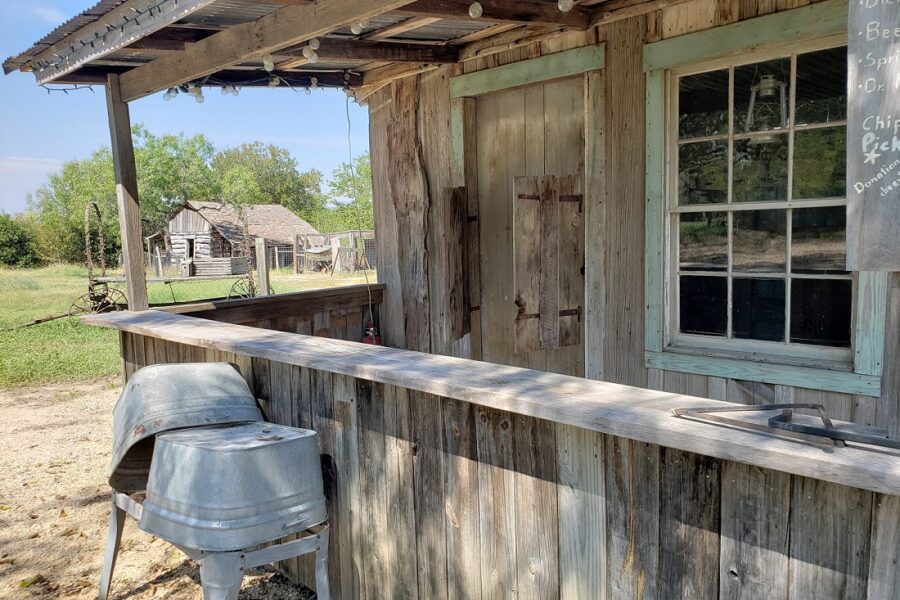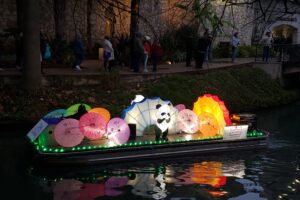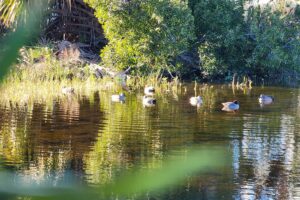This is the second time today we have pulled into an empty parking lot. Michael lets me know that the place we plan to visit is CLOSED. However, the gate that leads to the Gonzales Pioneer Village on the outskirts of town is open. This morning the gate was shut tight. So, I can say with authority, “No. Not closed. It’s open,” and then I explain about the gate.

We start down a path to the unknown. A bright red sign, low to the ground, warns us that we are entering the premises at our own risk. There is a hint of what is to come as we cross a small bridge; a roughly-hewn hand-lettered sign explains we are crossing Wild HOG Creek. I like this sign much better than the perfect green and white signs that line the highway in the 21st century; this sign has character!
We pass a prickly pear cactus loaded with its tuna fruit. I’ve never eaten a tuna, but now that I’m eye to eye with one, I can’t help but wonder if I’d like it.
We keep walking.

Gonzales Pioneer Village Living History Center
I know there is a small fee to visit this living history museum, but as we walk, there is no sign of an office or visitor center—or anything.
Suddenly, we are at the edge of a small antique village with a proper church, farms, outbuildings, chickens, and goats. To our left is a white clapboard house with a sign that says, Gift Shop. Mask in place, Michael walks in with his wallet at the ready and then walks out with a map in hand. It is our guide for the day.
According to the map we hold, there are 18 points of interest in the Gonzales Pioneer Village, which now, in the days of Covid-19, has an air of benign neglect and a bit of a ghost town feel.


The Church
The first building we venture into is a steeple-less church. At the side of the entrance is a well-placed sign explaining the history of the simple structure. It has gone through many incarnations, starting as a Presbyterian Church in the small community of Hamon (nine miles south of Gonzales), meandering through the years to eventually become a Baptist Church. After a century as a house of worship, it was converted into a community center, and sadly, ending its life in Hamon as a dilapidated hay barn.

The rest of the story, and how it managed to arrive at this village, is one of determination by a few and a labor of love by one man, Brian Buesing. Mr. Buesing rebuilt the church almost single-handedly.
A Place to Rest
Michael and I have a different timetable when it comes to touring museums. Odd things attract my attention, and I slowly amble, absorbing all that I see. Michael is always the proverbial miles ahead, as he is now. Eventually, we find each other in front of a house built in 1856 by Samuel Hardin Gates, originally constructed on land granted to Gates as a result of his actions in the Runaway Scrape in 1836.
The home was so deteriorated with age when it was rescued, that much of the wood that forms its outer walls had to be replaced. We sit a spell in two rockers on wood that is gray with the age, forming the front porch of this old home. The sweltering Texas sun seems to exhaust us today, and we are grateful that more than one of these buildings offers a brief respite and shade.




Farm Implements and Buildings
As I continue my wanderings, I almost feel like I am a kid again, romping around the outbuildings at my grandmother’s farm. The old weathered wood looks the same, but there was only sand underfoot—summer hot Texas sand—there was no grass at Grandma’s farm when I was a kid.
Finally, when I stumble into the old barn and see the corn sheller, it is déjà vu. I feel like I have struck gold–found the end of the rainbow. It was the late 1950’s when last I saw a corn sheller and tried to shell corn by myself. It was so much fun, and patient Aunt Ella let me work away. My grandmother never left the 19th century behind but took it with her, doing things the time-honored way. Perhaps the old-fashioned way. Or even perhaps the economical way. I never realized just how old that corn sheller was. This barn and the farm implements in it are circa 1870.



The Mansion
The last house I visit is the Muenzler House. Our host at Belle Oakes Inn refers to it as The Mansion. Looking at it, I can understand why. Among all the old weathered wood, it is the one bright white, pristinely clean, two-story building in this village circle. There are even beautiful pink roses growing in the yard.



Looking for my wayward husband, I’ve missed a few buildings, but I tell myself, “Next time.”
The Gonzales Pioneer Village Living History Center…
…is a non-profit organization that houses a collection of 1800s and early 1900s era houses and buildings from Gonzales County. Each structure has been donated to the association and was carefully relocated to the grounds of The Village for its preservation. Most of the furnishings and equipment found within these structures were either loaned or donated to represent the cultural lifestyle of the pioneers who settled this area.
Unfortunately, there is very little on-line information about this living history museum. Their website is under construction and other information available is a short paragraph on various other websites. This Gonzales attraction is definitely worth the trip. Children will be entertained—perhaps educated. Adults will be charmed, sparking memories of grandparents or great grandparents.
- Address: 2122 N St Joseph St, Gonzales, TX 78629
- Hours: Tuesday – Friday from 1-5 PM
- Phone: 830-672-2157
- Admission: Adults: $5, Children: $3
Places to Stay and Other Activities while in Gonzales
- The Belle Oaks Inn
- The Carriage House at the Belle Oaks Inn
- Visit Palmetto State Park
- Antiquing in Gonzales
- Dining at La Bella Tavola









Leave a Reply
Your email is safe with us.